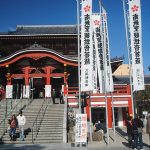Atsuta Shrine, located in the heart of Nagoya, is revered as one of the most significant Shinto shrines in the country, it attracts millions of pilgrims and tourists every year. The shrine offers a serene experience, appealing to history lovers, spirituality seekers, and families wanting to experience Japan’s rich cultural tapestry.
Historical Significance
The history of Atsuta Shrine is deeply ingrained in Japan’s mythology and imperial history. It is believed to house the sacred sword Kusanagi-no-Tsurugi, one of the three Imperial Regalia of Japan, representing the virtue of valor. The sword symbolizes the imperial lineage and, according to mythology, was bestowed by the Sun Goddess, Amaterasu, to the first emperors of Japan. However, the sword is not on public display, enveloping the shrine in an aura of mystique.
Local Significance
Locally, Atsuta Shrine is seen as a spiritual cornerstone, offering a place to connect with the divine and seek blessings and solace. It is a focal point for various Shinto ceremonies, festivals, and rituals reflecting the traditions and customs of the region, bringing together locals and visitors in celebration and reverence.
Annual Festivals at Atsuta Shrine:
- Atsuta Matsuri – June
The main festival of Atsuta Shrine is a vibrant event featuring traditional ceremonies, ritual dances, martial arts performances, processions, arts and crafts, and food stalls. - Shobu-sai (Iris Festival) – June
Celebrated with displays of beautiful iris flowers, this festival offers a visual feast during the bloom season. - Jingu Kito-sai – January and August
It is a serene event marked by prayers for world peace, prosperity, and happiness of the citizens. - Hatsu-uma-sai (First Horse Festival) – February
This festival involves ceremonies praying for a good harvest year, with offerings of the new crop to the deities. - Reisai (Annual Festival) – September
The Reisai is a spiritual event involving various ceremonies, prayers, and offerings.
Touristic Appeal
Atsuta Shrine’s sprawling grounds provide a peaceful retreat with architectural marvels and serene walking paths, all set against towering trees. Visitors can participate in traditional Shinto practices, explore the treasure halls displaying many relics and artifacts, and savor the tranquil ambiance of the shrine’s garden, especially when lanterns light up the shrine grounds in the evening.
Activities for Children
- Festivals
Children can witness and partake in the colorful festivals, learning through traditional dance, music, and parades. - Cultural Workshops
Periodic workshops are organized, letting children learn about traditional crafts and cultural activities. - Nature Exploration
The verdant grounds of the shrine are ideal for kids to explore and learn about local flora and fauna. - Traditional Cuisine
Families can relish the local cuisine at the eateries around the shrine, trying out traditional ‘katsu’ dishes.
Atsuta Shrine, with its historical richness, spiritual gravity, and cultural festivities, offers a multifaceted experience of Japan’s heritage. Whether you seek a spiritual connection, cultural immersion, or joyful celebration, the shrine and its festivals offer something for everyone, promising a fulfilling and memorable experience in Japan’s cultural and spiritual tapestry.
Drivephotographer, CC0, via Wikimedia Commons





Pingback: Shrines to Visit for New Years – Like Nagoya